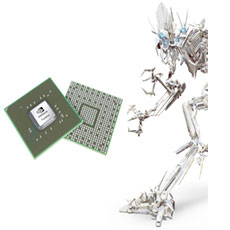PC Graphics Card Repair Miami

What is a Video Card ?
Graphics Card is an expansion card which generates output images to a display. Most video cards offer various functions such as accelerated rendering of 3D scenes and 2D, MPEG-2/MPEG-4 decoding, TV output, or the ability to connect multiple monitors. Other modern high performance video cards are used for more graphically demanding purposes, such as PC games. Video hardware is often integrated into the motherboard, however all modern motherboards provide expansion ports to which a video card can be attached. In this configuration it is sometimes referred to as a video controller or graphics controller. Modern low-end to mid-range motherboards often include a graphics chipset manufactured by the developer of the northbridge on the motherboard. This graphics chip usually has a small quantity of embedded memory and takes some of the system’s main RAM, reducing the total RAM available. This is usually called integrated graphics or on-board graphics, and is low-performance and undesirable for those wishing to run 3D applications. A dedicated graphics card on the other hand has its own RAM and Processor specifically for processing video images, and thus offloads this work from the CPU and system RAM. Almost all of these motherboards allow the disabling of the integrated graphics chip in Bios, and have an AGP,PCI and PCI Express slot for adding a higher-performance graphics card in place of the integrated graphics.
Sings of a Bad Graphics Card :
- Failure to boot while hearing a string of beep codes.
- If you power on the computer and there is no video.
- You will hear a string of beep codes to indicate a video adapter failure.
- If you see artifacts on your screen or other types of pixelation, your graphics card is probably going bad.
- If you DO see a BIOS boot screen when the PC begins to boot, but the monitor then goes blank as Windows loads, then you probably have a problem with your driver.
 Steven, L.
Steven, L.










